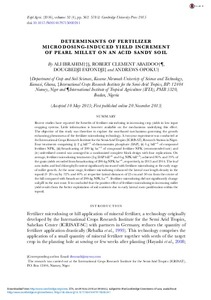| dc.contributor.author | Ibrahim, A. |
| dc.contributor.author | Abaidoo, R.C. |
| dc.contributor.author | Fatondji, D. |
| dc.contributor.author | Opoku, A. |
| dc.date.accessioned | 2019-12-04T11:04:30Z |
| dc.date.available | 2019-12-04T11:04:30Z |
| dc.date.issued | 2016-10 |
| dc.identifier.citation | Ibrahim, A., Abaidoo, R.C., Fatondji, D. & Opoku, A. (2016). Determinants of fertilizer microdosing-induced yield increment of pearl millet on an acid sandy soil. Experimental Agriculture, 52(4), 562-578. |
| dc.identifier.issn | 0014-4797 |
| dc.identifier.uri | https://hdl.handle.net/20.500.12478/1443 |
| dc.description | Published online: 20 November 2015 |
| dc.description.abstract | Recent studies have reported the benefits of fertilizer microdosing in increasing crop yields in low input cropping systems. Little information is however available on the mechanisms underlying this effect. The objective of this study was therefore to explore the root-based mechanisms governing the growth enhancing phenomena of the fertilizer microdosing technology. A two-year experiment was conducted at the International Crops Research Institute for the Semi-Arid Tropics (ICRISAT), Research Station in Niger. Four treatments comprising (i) 2 g hill−1 of diammonuim phosphate (DAP), (ii) 6 g hill−1 of compound fertilizer NPK, (iii) broadcasting of 200 kg ha−1 of compound fertilizer NPK (recommended rate) and (iv) unfertilized control was arranged in a randomized complete block design with four replications. On average, fertilizer microdosing treatments (2-g DAP hill−1 and 6-g NPK hill−1) achieved 86% and 79% of the grain yields recorded from broadcasting of 200-kg NPK ha−1, respectively, in 2013 and 2014. The leaf area index and leaf chlorophyll content significantly increased with fertilizer microdosing at the early stage of millet growth. At the same stage, fertilizer microdosing enhanced the lateral root length density in the topsoil (0–20 cm) by 72% and 40% at respective lateral distances of 25 cm and 50 cm from the centre of the hill compared with broadcast of 200-kg NPK ha−1. Fertilizer microdosing did not significantly change soil pH in the root zone. It is concluded that the positive effect of fertilizer microdosing in increasing millet yield results from the better exploitation of soil nutrients due to early lateral roots proliferation within the topsoil. |
| dc.description.sponsorship | Alliance for a Green Revolution in Africa |
| dc.format.extent | 562-578 |
| dc.language.iso | en |
| dc.subject | Fertilizers |
| dc.subject | Pearl Millet |
| dc.subject | Soil Fertility |
| dc.subject | Fertilizer Microdosing |
| dc.subject | Technology |
| dc.title | Determinants of fertilizer microdosing-induced yield increment of pearl millet on an acid sandy soil |
| dc.type | Journal Article |
| dc.description.version | Peer Review |
| cg.contributor.crp | Dryland Systems |
| cg.contributor.affiliation | Kwame Nkrumah University of Science and Technology |
| cg.contributor.affiliation | International Crops Research Institute for the Semi-Arid Tropics |
| cg.contributor.affiliation | International Institute of Tropical Agriculture |
| cg.coverage.region | Africa |
| cg.coverage.region | West Africa |
| cg.coverage.country | Niger |
| cg.isijournal | ISI Journal |
| cg.authorship.types | CGIAR and developing country institute |
| cg.iitasubject | Integrated Soil Fertility Management |
| cg.iitasubject | Soil Fertility |
| cg.journal | Experimental Agriculture |
| cg.howpublished | Formally Published |
| cg.accessibilitystatus | Limited Access |
| local.dspaceid | 79758 |
| cg.targetaudience | Scientists |
| cg.identifier.doi | https://dx.doi.org/10.1017/s0014479715000241 |

